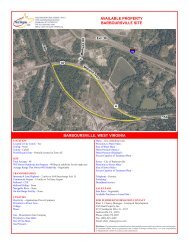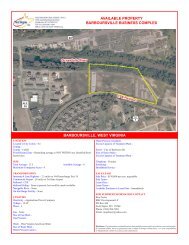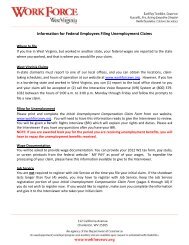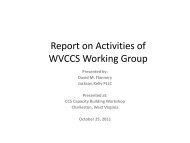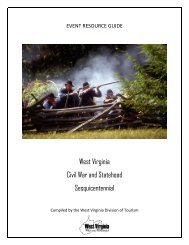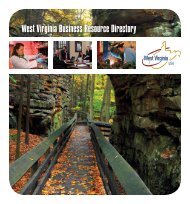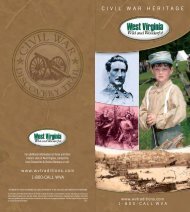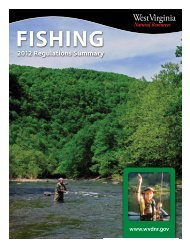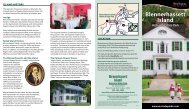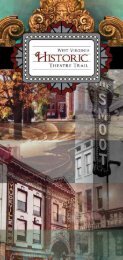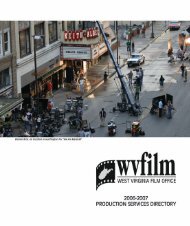Stateho - West Virginia Department of Commerce
Stateho - West Virginia Department of Commerce
Stateho - West Virginia Department of Commerce
Create successful ePaper yourself
Turn your PDF publications into a flip-book with our unique Google optimized e-Paper software.
When <strong>West</strong> <strong>Virginia</strong> became a state in 1863, the Capitol was at<br />
the Linsly Institute in Wheeling. In 1870, the state Legislature<br />
designated Charleston as the capital, and all state records and<br />
property were transported down the Ohio River and up the<br />
Kanawha River to their new home.<br />
In 1875, the Legislature voted to make Wheeling the capital.<br />
This was appealed by the citizens <strong>of</strong> Charleston and finally<br />
settled by the <strong>West</strong> <strong>Virginia</strong> Supreme Court <strong>of</strong> Appeals on Sept.<br />
13 in favor <strong>of</strong> Wheeling. However, state <strong>of</strong>ficials had boarded the<br />
steamers Emma Graham and Chesapeake on May 21 to start<br />
their trip to Wheeling. State archives and records did not arrive<br />
in Wheeling until late September aboard the Iron Valley steamer,<br />
bringing state government to a standstill for four months. On<br />
Dec. 14, 1876, the city <strong>of</strong> Wheeling presented <strong>West</strong> <strong>Virginia</strong> with<br />
a new stone structure costing $120,000.<br />
In 1877, the Legislature ordered an August election for the<br />
citizens <strong>of</strong> <strong>West</strong> <strong>Virginia</strong> to select a permanent location for the<br />
capital in Charleston, Martinsburg or Clarksburg. Thirty days<br />
after the election, Governor Henry M. Mathews proclaimed<br />
that after eight years, Charleston would be the government’s<br />
permanent seat. State <strong>of</strong>ficials again boarded the Chesapeake<br />
in May 1885 to move from Wheeling to Charleston. The steam<br />
towboat, Belle Prince, towed the barge, Nick Crewley, with its<br />
cargo <strong>of</strong> state records, papers and library.<br />
The new capitol opened May 1, 1885, and served for 36 years<br />
until its destruction by fire on Jan. 3, 1921. Ammunition,<br />
bought by the <strong>West</strong> <strong>Virginia</strong> State Police two years prior was<br />
stored on the top floor <strong>of</strong> the building. The ammunition had<br />
been purchased for use in the coal field disputes, which had<br />
threatened to erupt into civil war. Supposedly several machine<br />
guns and rifles also were stored in the capitol, so when the heat<br />
from the fire set <strong>of</strong>f the ammunition, the smoke could be seen<br />
for miles.<br />
A cry went out again to change the capital, with Clarksburg,<br />
Parkersburg and Huntington expressing interest. State <strong>of</strong>ficials<br />
authorized the building <strong>of</strong> a temporary capitol in Charleston one<br />
week after the fire. This building was constructed in 42 working<br />
days and lasted six years. The “Pasteboard Capitol,” as it was<br />
known due to its construction <strong>of</strong> clapboard and wallboard, was<br />
destroyed by a fire <strong>of</strong> unknown origin on March 2, 1927.<br />
Luckily, the Legislature had authorized the construction <strong>of</strong> the<br />
present Capitol on the north bank <strong>of</strong> the Kanawha River in 1921.<br />
This building was completed in 1932 at a cost <strong>of</strong> almost $10<br />
million.<br />
Floating Capitol<br />
The exterior <strong>of</strong> the Capitol is buff Indiana limestone. More than<br />
700 train carloads <strong>of</strong> limestone and 4,640 tons <strong>of</strong> steel were used<br />
in its construction. A special spur rail line was laid on the grounds<br />
to ship needed materials to the construction site.<br />
The magnificent 293-foot gold dome that tops the structure is five<br />
feet higher than the dome <strong>of</strong> the U.S. Capitol.<br />
The architect’s original plans called for gilding the dome’s ribs,<br />
tower, lantern, staff and eagle with gold leaf and painting the flat<br />
panels between the ribs. From 1988 to 1991, the entire dome<br />
was gilded in 23 ½ karat gold leaf applied to the copper and lead<br />
ro<strong>of</strong> in tiny 3 3/8-inch squares.<br />
The dome recently underwent restoration. The citizens <strong>of</strong> the state<br />
voted to return the dome back to its original design.<br />
Capitol Facts<br />
Architect - Cass Gilbert<br />
Completed - February 1932<br />
Cost - $9,491,180.03<br />
Ground Covered - 16 acres<br />
Floor Space - 535,000 square feet<br />
Outside Walls - over 700 carloads <strong>of</strong> Buff Indiana limestone<br />
Main Unit - Imperial Danby Vermont Marble<br />
Wings - Tennessee Marble<br />
Floors - White Vermont Marble and Italian travertine<br />
Dome - Chandelier is Czechoslovakian crystal weighing two tons;<br />
15,000 candle power; 179 feet, 9 inches from the floor; 54 footlong<br />
gold chain lowered by a hand winch at a set speed, requiring<br />
3½ hours to lower and 4½ hours to return to stationary position.<br />
The chandelier is lowered for cleaning every four years upon the<br />
inauguration <strong>of</strong> a new governor or re-election <strong>of</strong> an incumbent.
<strong>West</strong> <strong>Virginia</strong> Travel Regions<br />
Counties & County Seats
The longest single-span<br />
steel-arch bridge in the<br />
western hemisphere is<br />
the New River Gorge<br />
Bridge, stretching 3,030<br />
feet across the gorge. At<br />
876 feet above the New<br />
River, the bridge is also<br />
the second-highest in the<br />
United States.<br />
• The border <strong>of</strong> <strong>West</strong><br />
<strong>Virginia</strong> is 1,365 miles flat<br />
(as the crow flies).<br />
• <strong>West</strong> <strong>Virginia</strong>’s Memorial<br />
Tunnel was the first in the<br />
nation to be monitored<br />
by television. It opened<br />
November 8, 1954.<br />
• The first rural free mail<br />
delivery was started in<br />
Charles Town on October<br />
6, 1896, and then spread<br />
throughout the United<br />
States.<br />
• <strong>West</strong> <strong>Virginia</strong> was the<br />
first state to impose a sales<br />
tax. It became effective<br />
July 1, 1921.<br />
• The first steamboat<br />
was launched by James<br />
Rumsey in the Potomac River at New Mecklenburg (now<br />
Shepherdstown) on December 3, 1787.<br />
• Bailey Brown, the first Union soldier killed<br />
in the Civil War, died on May 22, 1861, at<br />
Fetterman in Taylor County.<br />
• A variety <strong>of</strong> the yellow apple, the Golden<br />
Delicious, originated in Clay County. The<br />
original Grimes Golden Apple tree was<br />
discovered in 1775 near Wellsburg.<br />
• <strong>West</strong> <strong>Virginia</strong> has a mean altitude <strong>of</strong> 1,500<br />
feet, making it the highest state east <strong>of</strong> the<br />
Mississippi.<br />
• The first iron furnace west <strong>of</strong> the<br />
Alleghenies was built by Peter Tarr on Kings<br />
Creek in 1794.<br />
• One <strong>of</strong> the first suspension bridges in<br />
the world was completed in Wheeling in<br />
November 1849.<br />
Unusual Facts about the Mountain State<br />
• Outdoor advertising had its origin in Wheeling about<br />
1908 when the Block Brothers Tobacco Company painted<br />
bridges and barns with the phrase, “Treat Yourself to the<br />
Best, Chew Mail Pouch.”<br />
• Moundsville is the site <strong>of</strong> the continent’s largest coneshaped<br />
prehistoric burial mound. It is 69 feet high and<br />
900 feet in circumference at the base and was opened to<br />
tourists in 1938.<br />
• The first electric railroad in the world, built as a<br />
commercial enterprise, was constructed between<br />
Huntington and Guyandotte.<br />
• “Paw-Paw,” nicknamed the “<strong>West</strong> <strong>Virginia</strong> banana,”<br />
originated in the state and took its name from Paw Paw, in<br />
Morgan County.<br />
• The 1500 block <strong>of</strong> <strong>Virginia</strong> Street in Charleston is the<br />
longest city block in the world.<br />
• <strong>West</strong> <strong>Virginia</strong> is the only state formed by presidential<br />
proclamation.<br />
• William Tompkins used natural gas to evaporate salt<br />
brine in 1841, thus becoming the first person in the United<br />
States to use natural gas for industrial<br />
purposes.<br />
• The first glass plant in <strong>West</strong><br />
<strong>Virginia</strong> was in Wellsburg in 1815.<br />
The first pottery plant was in<br />
Morgantown in 1785.<br />
• In May 1860, the first crude<br />
oil-producing well in the state was<br />
drilled at Burning Springs.<br />
The Tug Valley Chamber<br />
<strong>of</strong> <strong>Commerce</strong> in Williamson<br />
is located in a shiny,<br />
black building made <strong>of</strong><br />
coal blocks.<br />
• <strong>West</strong> <strong>Virginia</strong> contributed<br />
stone quarried near Hinton for the<br />
Washington Monument. The stone<br />
arrived in Washington in February<br />
1885.<br />
• A statue <strong>of</strong> John Henry stands<br />
atop Big Bend Mountain at John<br />
Henry Park in Talcott to honor the legend<br />
<strong>of</strong> America’s “Steel Drivin’ Man.”<br />
• The first memorial building to<br />
honor World War I veterans was<br />
dedicated on May 30, 1923, in<br />
Welch.<br />
• The first post <strong>of</strong>fice in <strong>West</strong><br />
<strong>Virginia</strong> was established on June<br />
30, 1792, in Martinsburg.<br />
• The first public spa opened at<br />
Berkeley Springs, <strong>West</strong> <strong>Virginia</strong>,<br />
in 1756 (then Bath, <strong>Virginia</strong>).<br />
• The first free school for<br />
African-Americans in the South<br />
opened in Parkersburg in 1862.<br />
• Mrs. Minnie Buckingham<br />
Harper, a member <strong>of</strong> the House<br />
<strong>of</strong> Delegates by appointment in 1928, was the first African-<br />
American woman to become a member <strong>of</strong> a legislative body<br />
in the United States.<br />
• Chester Merriman <strong>of</strong> Romney was the youngest soldier <strong>of</strong><br />
World War I, enlisting at age 14.<br />
• White Sulphur Springs, Greenbrier County, was the first<br />
“summer White House.”<br />
• The first brick street<br />
in the world was laid<br />
in Charleston, <strong>West</strong><br />
<strong>Virginia</strong>, in the early<br />
1870s, on Summers<br />
Street, between<br />
Kanawha and <strong>Virginia</strong><br />
streets.<br />
Organ Cave, near Ronceverte, is the<br />
second-largest cave in the Eastern United<br />
States and the largest in the state.<br />
Mother’s Day was first<br />
observed at Andrews<br />
Church in Grafton on<br />
May 10, 1908.<br />
• America’s first<br />
organized golf club,<br />
Oakhurst Links, was<br />
established in 1884 at<br />
White Sulphur Springs,<br />
<strong>West</strong> <strong>Virginia</strong>.<br />
• The National Radio Astronomy Observatory in Green<br />
Bank is home to the largest fully steerable satellite dish in<br />
the world.
Famous <strong>West</strong> <strong>Virginia</strong>ns<br />
A sampling <strong>of</strong> the many famous <strong>West</strong> <strong>Virginia</strong>ns<br />
Pearl S. Buck - Pulitzer Prize- and Nobel Prize-winning author,<br />
born in Hillsboro, Pocahontas County.<br />
Hal Greer - Member <strong>of</strong> the Basketball Hall <strong>of</strong> Fame, raised in<br />
Huntington, Cabell County.<br />
Homer H. Hickam, Jr. - Author <strong>of</strong> Rocket Boys: A Memoir, the<br />
story <strong>of</strong> his life in the little town <strong>of</strong> Coalwood, WV, that inspired<br />
the #1 bestseller and award-winning movie October Sky.<br />
Thomas “Stonewall” Jackson - Confederate General’s<br />
boyhood home became the first state 4-H Club Camp in the<br />
United States. Born in Clarksburg, Harrison County.<br />
Don Knotts - Actor best known for his role as “Barney<br />
Fife” from “The Andy Griffith Show.” Born and raised in<br />
Morgantown, Monongalia County.<br />
Kathy Mattea - World-renowned country music artist was<br />
born and raised in Cross Lanes, Kanawha County.<br />
John Forbes Nash Jr. - 1994 Nobel Prize winning<br />
mathematician who was the subject <strong>of</strong> the 1998 biography<br />
and 2002 film “A Beautiful Mind.” Born and raised in Bluefield,<br />
Mercer County.<br />
Brad Paisley - Popular country music artist and member <strong>of</strong><br />
the Grand Ol’ Opry, born in Glen Dale, <strong>West</strong> <strong>Virginia</strong>.<br />
Mary Lou Retton - 1984 Olympic Gold Medal winner in<br />
gymnastics, from Fairmont, Marion County.<br />
Alex Schoenbaum - Founder <strong>of</strong> the Shoney’s Restaurant<br />
chain, one <strong>of</strong> the largest businesses to originate in <strong>West</strong><br />
<strong>Virginia</strong>.<br />
Rev. Dr. Leon Sullivan - A native <strong>of</strong> <strong>West</strong> <strong>Virginia</strong>, was<br />
a preacher, social activist and educator who founded the<br />
Sullivan Principles <strong>of</strong> Equal Opportunity, which became a<br />
blueprint for ending apartheid and an international standard for<br />
human rights.<br />
Cyrus R. Vance - Secretary <strong>of</strong> State from 1977 to 1980<br />
during the administration <strong>of</strong> President Jimmy Carter, born in<br />
Clarksburg, Harrison County.<br />
Booker T. Washington - Black educational leader and the first<br />
president <strong>of</strong> Tuskegee Institute, raised in Malden, Kanawha<br />
County.<br />
Jerry <strong>West</strong> - Former pr<strong>of</strong>essional basketball star <strong>of</strong> the Los<br />
Angeles Lakers and Basketball Hall <strong>of</strong> Fame member, born in<br />
Cabin Creek, Kanawha County.<br />
Carter G. Woodson - Educator, author and the father <strong>of</strong> Black<br />
History Month, raised in Huntington, Cabell County.<br />
Brigadier General Charles Yeager, U.S.A.F Retired - First<br />
person to fly faster than the speed <strong>of</strong> sound, born in Myra,<br />
Lincoln County.
The Cardinal, or Cardinalis cardinalis, became<br />
<strong>West</strong> <strong>Virginia</strong>’s <strong>of</strong>ficial bird in 1949 by the<br />
Legislature authorizing a vote by pupils <strong>of</strong> public<br />
schools and civic organizations. The male cardinal<br />
is a rich scarlet color with a mask and shading<br />
<strong>of</strong> black, while the young and females are a lessbrilliant<br />
color. The cardinal measures approximately<br />
eight inches long and is found from New York to the<br />
Gulf <strong>of</strong> Mexico and as far west as Oklahoma.<br />
The Sugar Maple, Acer saccarum, became<br />
<strong>West</strong> <strong>Virginia</strong>’s <strong>of</strong>ficial tree by a resolution <strong>of</strong><br />
the 1949 Legislature. Its wood is excellent<br />
for furniture, and it produces maple syrup. A<br />
single tree is 70-120 feet high and produces<br />
two to three pounds <strong>of</strong> sap sugar. It has a fivelobed<br />
leaf and a small wing-shaped seed pod<br />
and, in the fall, the leaves turn brilliant colors.<br />
<br />
Joseph H. Diss Debar, an artist from Doddridge County, was chosen<br />
by a committee <strong>of</strong> the Legislature to prepare drawings for an <strong>of</strong>ficial<br />
seal for the State <strong>of</strong> <strong>West</strong> <strong>Virginia</strong>. The artist submitted his drawings<br />
with an explanation <strong>of</strong> each detail and from these was adopted, by<br />
the Legislature, a seal that has remained without change, the Official<br />
Seal <strong>of</strong> <strong>West</strong> <strong>Virginia</strong>. The seal contains the Latin motto, Montani<br />
Semper Liberi, which means “Mountaineers<br />
Are Always Free.” A large stone in<br />
the center <strong>of</strong> the seal stands for<br />
strength. On the stone is the date<br />
the state was admitted to the Union,<br />
June 20, 1863. The farmer with his<br />
ax represents agriculture, and the<br />
miner holding his pick represents<br />
industry. In front <strong>of</strong> the rock are two<br />
rifles, crossed and surmounted at the<br />
place <strong>of</strong> contact by the Phrygian cap, or<br />
cap <strong>of</strong> liberty, indicating the fight for<br />
freedom and liberty. While the seal<br />
was designed and adopted with<br />
two sides, only the front side is in<br />
common use.<br />
The reverse side <strong>of</strong> laurel and oak<br />
leaves, log house, hills, factories and<br />
boats is the Governor’s Official Seal. The<br />
Constitution <strong>of</strong> <strong>West</strong> <strong>Virginia</strong> provides that: “The present seal <strong>of</strong> the<br />
state, with its motto ‘Montani Semper Liberi,’ shall be the great seal<br />
<strong>of</strong> the State <strong>of</strong> <strong>West</strong> <strong>Virginia</strong>, and shall be kept by the secretary <strong>of</strong><br />
state, to be used by him, <strong>of</strong>ficially as directed by law.”<br />
The Black Bear, or Ursus americanus,<br />
is actually deeply tinted with brown.<br />
The black bear roams freely throughout<br />
36 states and Canada, while its <strong>West</strong><br />
<strong>Virginia</strong> habitat primarily is in the eastern<br />
mountain region <strong>of</strong> the state. One or two<br />
cubs, rarely three, are born at a time,<br />
weighing about eight ounces each. The<br />
adult reaches an average maximum<br />
weight <strong>of</strong> 250 pounds. Selected in 1954-<br />
55 and adopted by the Legislature as the<br />
<strong>of</strong>ficial state animal on March 23, 1973.<br />
The Rhododendron maximum, or “big laurel,” is the state<br />
flower <strong>of</strong> <strong>West</strong> <strong>Virginia</strong>. It was adopted by the Legislature<br />
on January 23, 1903 following a recommendation by the<br />
Governor and a vote by the pupils <strong>of</strong> public schools. It<br />
is a shrub <strong>of</strong> the heath family and may be recognized by<br />
its large, dark evergreen leaves and delicate pale pink or<br />
white bloom, with either red or yellow flecks.<br />
<br />
By Senate Joint Resolution and approved by the Legislature<br />
March 7, 1929, <strong>West</strong> <strong>Virginia</strong> adopted the present State Flag.<br />
The resolution in part is as follows: “That the Legislature <strong>of</strong><br />
<strong>West</strong> <strong>Virginia</strong> hereby adopts a state flag <strong>of</strong> the following design<br />
and proportions:<br />
The proportions <strong>of</strong><br />
the flag <strong>of</strong> the State<br />
<strong>of</strong> <strong>West</strong> <strong>Virginia</strong> is the<br />
same as those <strong>of</strong> the<br />
United States ensign;<br />
centered on a field <strong>of</strong><br />
pure white is the coat<strong>of</strong><br />
arms <strong>of</strong> the State <strong>of</strong><br />
<strong>West</strong> <strong>Virginia</strong> and the<br />
date <strong>of</strong> the admission<br />
<strong>of</strong> the State into the<br />
Union, with the motto,<br />
‘Montani Semper Liberi’<br />
(Mountaineers Are<br />
Always Free). Above the<br />
coat-<strong>of</strong>-arms is a ribbon<br />
lettered, ‘State <strong>of</strong> <strong>West</strong> <strong>Virginia</strong>,’ and arranged around the lower<br />
part <strong>of</strong> the coat-<strong>of</strong>-arms is a wreath <strong>of</strong> Rhododendron maximum<br />
in proper colors. The field <strong>of</strong> pure white is bordered by a strip<br />
<strong>of</strong> blue on four sides. The flag, when used for parade purposes,<br />
shall be trimmed with gold-colored fringe on three sides and,<br />
when used on ceremonial occasions with the United States<br />
ensign, is trimmed and mounted in similar fashion to the United<br />
States flag as regards to fringe, cord, tassels, and mounting.<br />
The Golden Delicious Apple was<br />
designated as the <strong>of</strong>ficial state fruit<br />
by the Legislature on February 20,<br />
1995. Anderson Mullins discovered<br />
this apple variety in Clay County<br />
in 1905. The plain apple had been<br />
previously designated as the<br />
<strong>of</strong>ficial state fruit on<br />
March 7, 1972.<br />
The Brook Trout, a<br />
<strong>West</strong> <strong>Virginia</strong> native<br />
fish, is perhaps the<br />
most-sought-after<br />
trout by anglers,<br />
as it puts up an<br />
excellent fight for<br />
its size. It thrives in small, cold, spring-fed streams and is unable to withstand warmer<br />
temperatures. The brook trout is olive with lighter sides and a reddish belly (in males) and<br />
is easily identified by the light-colored edges <strong>of</strong> the lower fins. Adopted as the State Fish<br />
March 23, 1973, during regular session following a poll <strong>of</strong> sportsmen.<br />
The Honeybee became <strong>West</strong> <strong>Virginia</strong>’s<br />
<strong>of</strong>ficial state insect on March 7, 2002, by<br />
the Legislature. In addition to its flavorful<br />
honey, the honeybee pollinates many <strong>of</strong><br />
the state’s most important crops including<br />
fruits, vegetables and grasses. Its activity<br />
produces more benefit to the state’s<br />
economy than any other insect. The<br />
honeybee has six legs, four wings and its<br />
coloring ranges from dark yellow to gold<br />
with three dark bands on its abdomen.<br />
The Monarch Butterfly was designated<br />
<strong>West</strong> <strong>Virginia</strong>’s <strong>of</strong>ficial state butterfly on<br />
March 1, 1995, by the Legislature. The<br />
orange and black insect dines on milkweed<br />
as a caterpillar, sips nectar from flowers as<br />
a butterfly and, at summer’s end, migrates<br />
south to Mexico. The butterflies you see in<br />
the spring are the great grandchildren <strong>of</strong> the<br />
ones that lived in Mexico during the winter.<br />
<br />
State Nickname<br />
“The Mountain State”<br />
State Songs<br />
Although many people consider John Denver’s “Country Roads” the state’s un<strong>of</strong>ficial<br />
anthem, the Legislature adopted the following three <strong>of</strong>ficial state songs on February<br />
28, 1963: The <strong>West</strong> <strong>Virginia</strong> Hills, words and music by Ellen King and H.E. Engle;<br />
This is My <strong>West</strong> <strong>Virginia</strong>, by Iris Bell; and <strong>West</strong> <strong>Virginia</strong>, My Home Sweet Home, by<br />
Julian G. Hearne, Jr.<br />
State Day<br />
June 20. <strong>West</strong> <strong>Virginia</strong> was proclaimed a state in 1863. “<strong>West</strong> <strong>Virginia</strong> Day” became<br />
a legal holiday in 1927.<br />
State Gem<br />
The State Gem is technically not a gemstone, but rather the silicified Mississippian<br />
Fossil Coral, Lithostrotionella, preserved as the siliceous mineral chalcedony.<br />
Designated by House Concurrent Resolution March 10, 1990. It is found in Hillsdale<br />
Limestone in portions <strong>of</strong> Greenbrier and Pocahontas counties and is <strong>of</strong>ten cut and<br />
polished for jewelry and display.<br />
State Soil<br />
The state soil is Monongahela Silt Loam, adopted on April 2, 1997, making<br />
<strong>West</strong> <strong>Virginia</strong> the 12th state to have an <strong>of</strong>ficial state soil.<br />
Official Colors<br />
Old Gold and Blue were designated as <strong>of</strong>ficial state colors adopted by the Legislature<br />
on March 8, 1963.<br />
For more information on <strong>West</strong> <strong>Virginia</strong> visit our web site<br />
www.callwva.com
<strong>West</strong> <strong>Virginia</strong>’s borders are within a day’s drive<br />
<strong>of</strong> most <strong>of</strong> the eastern United States.<br />
<strong>West</strong> <strong>Virginia</strong> Division <strong>of</strong> Tourism<br />
90 MacCorkle Ave., SW<br />
South Charleston, WV 25303<br />
1-800-CALL WVA<br />
www.callwva.com<br />
The <strong>West</strong> <strong>Virginia</strong> Division <strong>of</strong> Tourism is an equal opportunity employer. 9/28/07



